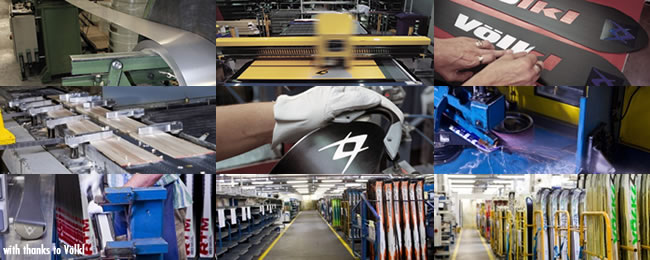If you’re in the market for new skis, you’ll discover a wild diversity in prices. Skis that sell with bindings for $399 are arrayed alongside models with sticker prices well above $1,000, bindings not included.
Fischer Motive X : MSRP $399.99
What does the $1,000 ski have that the sub-$400 model doesn’t, other than the hope of fishing a minimum of 600 more dollars out of your income stream?
The answer, in brief, is more of everything. To make a ski intended to retail at $400 with an adult binding, the ski has to be made very efficiently, i.e., with a minimum of manual intervention. The fewer parts, the better. Materials and methods are selected with an eye to lowering the costs of manufacture to rock bottom.
If the finance fairy comes along and triples the R&D budget, the ski designer can focus on optimizing performance instead of minimizing price. Every element in the $399 ski is jettisoned for a superior component.
The base material changes from a soft, easily abraded polyethylene to an ultra-high molecular weight PE. The core, which acts as little more than a spacer in the low-end model, becomes a carefully composed laminate of woods selected for specific properties. Fiberglass is pre-impregnated with resin so it can be deployed with its fibers in precisely the alignment the designer desires.
With the budgetary reins loosened, the ski maker can add more expensive materials to the ski recipe, like carbon fiber and titanium alloy. The purpose of adding these elements is to selectively stiffen the ski and manage vibration by damping deleterious shocks that disrupt edge grip.
Out on the hill, the more expensive ski will maintain better edge contact in the most critical condition, which is hard snow at high speed. Additional shock absorbing elements are often incorporated in or on top of competition skis to keep them connected to what passes for “snow” on a racecourse. The more you prize stability at speed, the more you should expect to pay for a ski.
Assembling all the extra elements that go into the pricier ski requires the human touch. Molding a performance ski is an interesting amalgam of craftsmanship and automation. From a production perspective, the history of ski making has been an ongoing quest to produce a more consistent product. The challenge has been maintaining strict quality control while manufacturing sufficient quantities to be sustainable.
The main contributors to the cost of the $1,000 ski are a sophisticated level of industrialization combined with handmade skills that create a perfect ski every time, including a base finishing process that reproduces a flawless edge. To make a consistent $399 ski requires clever tooling and less investment in the finishing steps that separate average from excellent.
The easiest way to add expense to a ski’s make-up is to make it bigger. Ski makers have to pay for all their raw materials, so if they use more wood, or fiberglass or metal – in say, a 120mm-wide powder ski – they increase their costs. For any given construction, the fatter the ski, the more grease it takes to make. Ski makers would love it if they could charge for length as well, but they aren’t about to challenge the status quo on this front.
Volkl V-Werks Katana: MSRP $1275
Putting it all in perspective, there are three qualities that make more expensive skis worth it:
- they maintain better edge contact in all conditions, at any speed;
- they’re delivered in better condition and will perform better for longer;
- and there’s more to them, literally, figuratively, any way you slice it.
Or as a long-since retired ski sales rep once pithily opined, “Better skis ski better.”




